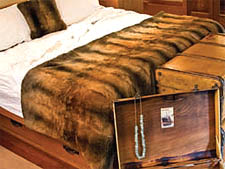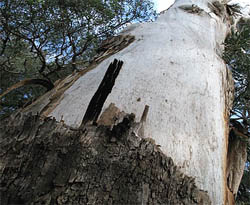This scene is repeated hundreds of times nightly in New Zealand. Far from blood sport opportunists, these hunters are champion conservationists— forging a tradition of protecting New Zealand’s delicate ecology by marketing fur fiber and pelts to manufacturers who create practical yet luxurious garments and accessories. It turns out that money really does grow on trees in New Zealand.
Kiwis are quick to say that paihamu (Australian brushtail possum) are not welcome in their fair land. “The only good one is a dead one” is a common mutter concerning the animal that was brought in by settlers to establish a fur industry in New Zealand. They clearly recognize the difference between an invasive species and ecological welfare. They have had plenty of time to form their arguments.
The Possum Tale
In the mid-1800s, Europeans colonized New Zealand with non-native plants and grazing animals as sources of food and fiber. Because New Zealand has no native mammals (except for two small species of bats), the colonists introduced an Australian possum, an 8- to 12-pound southern hemisphere marsupial. The indigenous named it “paihamu” (pie-ha-moo)—meaning “excellent forager” in Maori.
The land was paihamu paradise. With no large predators, New Zealand is replete with flightless birds and insects. Unlike Australia, New Zealand flora has no large predators, thorns, or natural chemical defenses to stop the paihamu, which stripped trees to the point of killing them. It thrived with its unrestricted reproductive rate of 30 percent. The paihamu population explosion had begun.
Paihamu fur clothing was popular with the Maori, European settlers, and a growing export market. In the 1950s, despite a thriving fashion business, the ecological damage was outpacing the paihamu harvest. Helicopter flights over the vast bush countryside revealed dying tree canopies at the jaws of paihamu. At the same time, synthetic fibers, including acrylic, an inexpensive wool-like fleece, were introduced. By 1965, synthetic fibers owned more than 40 percent of the U.S. fiber market and acrylic “eco-fleece” was quickly dominating the market long held by natural fiber sheepskin and other furs. As demand for paihamu products declined, its population rose, prompting the New Zealand government to introduce aerial chemical poisoning as a modernday control and conservation method.
The invasive paihamu now occupies more than 99 percent of New Zealand. Estimates on total numbers range from 50 to 80 million. At 70 million, there are 17 paihamu for every man, woman, and child in New Zealand.
Ignoring ecological and environmental ideals, urban- based animal rights groups blurred the lines between animal welfare and animal rights. They systematically took over animal welfare associations, merged into the conservation movement, and initiated new “green” taboos against animal-sourced clothing, further strengthening the sales of synthetics.
Exports of paihamu pelts peaked at 3.2 million before cheap, mass-marketed synthetics flooded the marketplace. Wild fur sales crashed with the stock market and the United States entered a recession. The New Zealand auction house where pelts were sold shut its doors as paihamu pelt exports bottomed out at 100,000 at the end of the 1980s. The press claimed “fur is dead.” It would take nearly two decades before they reported on the recovery.
Rising incomes coupled with increased cost of oil (the feedstock for synthetics), and a new-found respect for renewables and biodegradables, won new fans for natural fibers around the world. Wool, bamboo, organic cotton, and to a lesser extent, hemp, were embraced as leaders in the sustainable movement. Until recently, however, paihamu fiber was left behind in the world’s search for a sustainable natural fiber with premium qualities.
Ecological Dilema
The invasive paihamu now occupies more than 99 percent of New Zealand. Estimates on total numbers range from 50 to 80 million. At 70 million, there are 17 paihamu for every man, woman, and child in New Zealand. The paihamu eat 20,000 tons of vegetation nightly, enough to fill a container ship every 24 hours. In addition to the loss of oxygen caused by this massive consumption, New Zealand pastoralists fear it as a threat to their livestock since paihamu can carry tuberculosis.
Costs to the unique New Zealand environment are measured in habitat destruction, long-term changes in forest composition, canopy collapse, and native plant extinctions due to overgrazing. Impacts on native wildlife include competition for food and habitat and predation of indigenous species, birds and eggs. The International Union for the Conservation of Nature lists the destructive paihamu as one of the world’s worst invasive species.
“They’re probably the number one threat to our native species, to the birds and the native forest plants of New Zealand,” said Helen Bain, spokeswoman for the Royal Forest and Bird Protection Society.
Most of the government’s money is spent aerially spreading toxic poison, sodium fluoroacetate (1080), across vast acres of land, indiscriminately killing other animals through collateral poisoning.
Precious taxpayer dollars—about NZ$70 million (approximately US$43 million) annually in recent years—are transferred from education, health, and infrastructure to paihamu control. Such efforts reduce the paihamu population by about 3 million animals a year. Subtract this from 50 million (the conservative estimate) that are reproducing at a clip of 30 percent a year, and New Zealand is easily adding another 10 million to the animal’s burgeoning population this year. Next year, the number compounds again.
Most of the government’s money is spent aerially spreading toxic poison, sodium fluoroacetate (1080), across vast acres of land, indiscriminately killing other animals through collateral poisoning or secondary poisoning (animals scavenging on a poisoned body). Iconic birds, the very animals they are trying to preserve, have been poisoned in this way. Using 1080 is a contentious issue in the country, with New Zealand’s Department of Conservation (DOC) asserting it is safe to use, and others claiming the DOC studies are inaccurate. Websites such as stop1080poison.com and grafboys.org show the damaging effects of 1080.
Cozying up to Eco-Friendly Fur
The Kiwis are a feisty lot. Where the government has failed to stem the paihamu population, the market is stepping in to solve the ecological and animal welfare issues, while returning value to New Zealanders in the form of jobs and more money in the tax coffers. Rather than toss dollars and 1080 at this endless and futile battle, a group of trappers, manufacturers, and industry people have formed the New Zealand Fur Council with the goal of using the private market to solve the problem—it is recognized as a groundbreaking development offering a sustainable, market-based solution for controlling an invasive species. Its mission is to maximize the commercial opportunities for paihamu products and assist in the protection of New Zealand’s biodiversity through paihamu harvesting.
The council is working on realistic and practical solutions that include harvesting the pelts, leather, fur fiber, and meat to create goods for the world market. They have reached across the ocean to once again explore the U.S. market.
There is hope for New Zealand’s ecology, environment, and even its economy if conservationists are able to explain to the buying public two things: The only other alternative (1080) fails on an animal welfare and ecological level; and the time is ripe to switch from “inexpensive,” nonbiodegradable, unsustainable synthetics to natural fibers, specifically premium products made from paihamu.
The premier U.S. importer, Eco-Luxury Fur, heralds luxurious paihamu fur throws, pillows, and rugs as the “softer side of leather.” Touting the fur’s physical characteristics as gorgeous, soft, and silky, the website appeals to the thoughtful conservationist, the person who understands not only the animal welfare issues, but also appreciates the compelling ecological ideal. Customers are individuals who enjoy the exotic and authentic look the products add to a room, not achievable by a fake fur that will never biodegrade.

In 2009, 100,000 kilograms of fiber will be recovered, reducing the paihamu population by 2 million. The fiber will be used in the new wool/fur yarns hybrid in an industry valued at $NZ10 (US$6) million at wholesale, estimated at $NZ70 (US$43) million retail and growing at an impressive pace.
Eco-Luxury Fur sells wool/fur fiber products online and through retailers via Wild-Wool.com. Not only are the wool and fur sourced from New Zealand, but the products are manufactured in New Zealand. Keeping the manufacturing in New Zealand is consistent with Eco-Luxury Fur’s ideals of adding as much value to the paihamu in New Zealand as possible before shipping it to the vast global market.
“While only 40 designers used natural fiber furs in the 1980s, today more than 400 embrace it,” said Teresa Platt, executive director of Fur Commission USA and a PERC enviropreneur fellow. “Eco-Luxury Fur’s effort is innovative and the Merino wool/fur fiber hybrid is a breakthrough product. I own and enjoy several wonderful paihamu pieces, but I swear by the socks. Every hunter, fisherman, and hiker needs to try them.”
My goal is to put Eco-Luxury Fur out of business for lack of Paihamu inventory in New Zealand. When the Paihamu population is down to a level where native animals and plants no longer are threatened, then I will tuck into my last throw and read a book.
Use of the paihamu fiber also allows separate sale of the leather, believed to be the second strongest in the world. Such hides should appeal to leather-loving conservationists as they yield conservation gains for each item sold. Eco-Luxury Fur is talking with several potential buyers of the leather to make high-end, eco-friendly products.
When evaluating the factors for determining whether a product is authentically eco-friendly, both paihamu hide products and Merino/paihamu hybrids (unlike faux fur, synthetics, and even cotton) fulfill nearly all of them.
There is hope for New Zealand’s ecology, environment, and even its economy if conservationists are able to explain to the buying public two things: The only other alternative (1080) fails on an animal welfare and ecological level; and the time is ripe to switch from “inexpensive,” nonbiodegradable, unsustainable synthetics to natural fibers, specifically premium products made from paihamu. The best source of leather, fur, and fiber is an invasive species whose destructive existence requires humane abatement.




